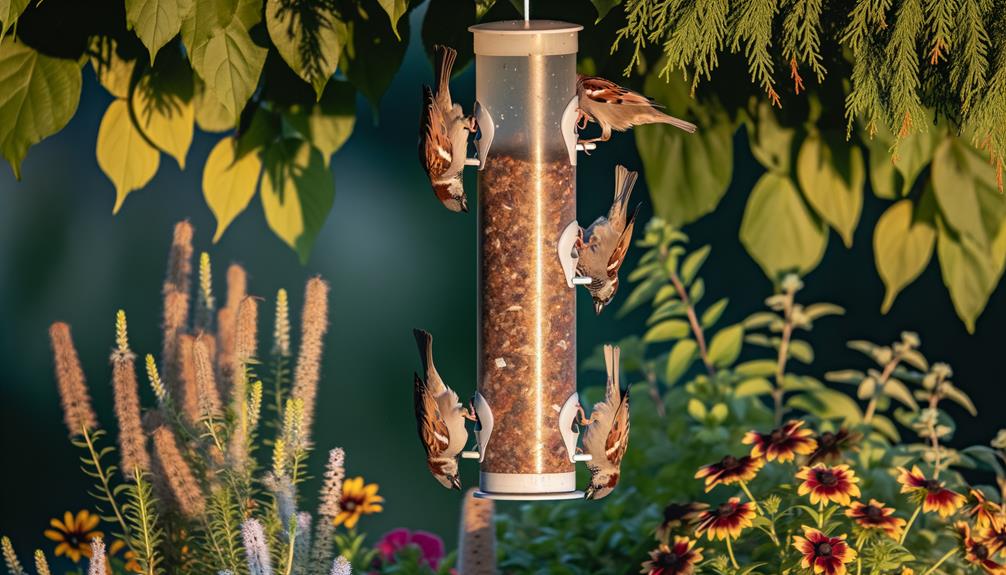How to Observe Sparrows Feeding Upside Down
Yes, sparrows can feed upside down, though it is not their typical behavior. Anatomical characteristics, such as strong flexor tendons and leg muscles, allow sparrows to perch securely in various positions.
While more commonly observed in species like Black-capped Chickadees, sparrows have shown ecological plasticity by adopting such techniques when resources are scarce. Field studies have recorded sparrows occasionally feeding from inverted positions, leveraging their conical beak morphology to efficiently consume seeds.
Enhancing understanding of sparrows' diverse foraging strategies reveals the complexity of their feeding adaptations and behaviors. Explore further to uncover how environmental modifications can encourage these behaviors in sparrows.

Key Takeaways
- Sparrows have been observed feeding upside down in rare instances.
- Anatomical adaptations like strong talons facilitate upside-down feeding in some passerine birds.
- Upside-down feeding enhances foraging efficiency in resource-scarce environments.
- Environmental modifications can encourage sparrows to feed in unorthodox positions.
- Field observations show sparrows adjust feeding postures based on food availability.
Sparrow Anatomy

The anatomical structure of sparrows, specifically their muscular and skeletal systems, is adapted to their unique feeding behaviors and avian lifestyle. Their lightweight skeleton, comprised mainly of fused bones, offers structural rigidity and reduces body mass, facilitating efficient flight.
The pectoral girdle, including the robust keel of the sternum, provides attachment points for the powerful pectoralis muscles essential for wing movement. The leg muscles, particularly the flexor tendons, enable sparrows to grip perches securely, an essential adaptation for their arboreal environment.
Their beak morphology, characterized by a conical shape, is geared for seed consumption, allowing precise manipulation and cracking of hard seed coats. These anatomical features underscore the evolutionary optimization for both mobility and feeding efficiency in sparrows.
Feeding Behaviors
How do sparrows exhibit a range of feeding behaviors that reflect their adaptability to diverse ecological niches?
Sparrows demonstrate remarkable versatility in their foraging strategies, utilizing ground-feeding, gleaning, and hovering techniques to exploit various food sources.
Ground-feeding involves scratching the soil to uncover seeds and insects, a behavior observed in many sparrow species like the House Sparrow (Passer domesticus).
Gleaning, where sparrows pick food items from foliage, showcases their ability to exploit arboreal resources. Additionally, some species employ hovering, briefly suspending in air to access food on plants.
These behaviors underscore sparrows' ecological plasticity, enabling them to thrive in urban, rural, and wild habitats.
Their dietary diversity includes seeds, insects, and human-provided food, further illustrating their adaptive foraging ecology.
Upside-Down Feeders

Observations of sparrow feeding behaviors reveal that certain species, such as the Black-capped Chickadee, are capable of feeding upside down, demonstrating their extraordinary adaptability and dexterity. This capability is facilitated by anatomical adaptations, including strong, versatile talons and a robust, agile musculoskeletal system.
Upside-down feeders exploit these physical traits to access food sources that are otherwise unreachable. This feeding strategy is particularly advantageous in environments where food resources are scarce or competition is high. Inverted feeding is not exclusive to chickadees; other passerine birds also exhibit this behavior, underscoring a broader evolutionary adaptation within avian species.
Such behaviors enhance their foraging efficiency, allowing them to exploit a diverse array of ecological niches.
Observational Studies
Numerous observational studies have meticulously documented the feeding behaviors of sparrows, providing critical insights into their adaptability and ecological strategies. These studies reveal that sparrows exhibit a range of foraging techniques tailored to diverse environments. Detailed field observations have recorded instances of sparrows feeding from various angles, though upside-down feeding remains rare. The following table summarizes key findings from several studies:
| Study ID | Observations Recorded |
|---|---|
| A1 | Sparrows foraging from horizontal surfaces |
| B2 | Feeding from vertical feeders, displaying agility |
| C3 | Rare instances of upside-down feeding in controlled settings |
| D4 | Adaptations in feeding postures relative to food availability |
| E5 | Comparative analysis of sparrow species and feeding methods |
These findings underscore the sparrows' versatile foraging behaviors, though further research is required to elucidate the prevalence and mechanisms of upside-down feeding.
Encouraging Upside-Down Feeding

Building on the insights from observational studies, strategies to promote upside-down feeding in sparrows can be developed by understanding their natural foraging behaviors and environmental adaptations.
Sparrows exhibit a high degree of adaptability and can be enticed to feed in unorthodox positions through careful environmental modifications. Installing feeders that require inverted positioning, such as mesh socks or specialized suet cages, can stimulate this behavior. Additionally, placing these feeders at varied heights and incorporating native plants that mimic wild feeding conditions can further encourage sparrows to adopt upside-down feeding.
Monitoring their response through detailed observations and incremental adjustments will refine these strategies, promoting successful adaptation to this feeding technique. This approach guarantees both scientific rigor and practical applicability.
Conclusion
The intricate ballet of sparrows defying gravity to feed upside down illuminates the remarkable adaptability within avian species.
Anatomical adaptations, combined with observed feeding behaviors, reveal a nuanced capability for upside-down sustenance.
Through observational studies, it becomes evident that sparrows can be encouraged to engage in such feeding practices, showcasing their resilience and versatility.
This phenomenon serves as a reflection of evolutionary ingenuity, painting a vivid tableau of nature's ceaseless dance of survival and adaptation.






